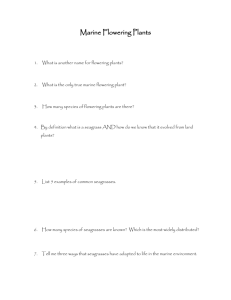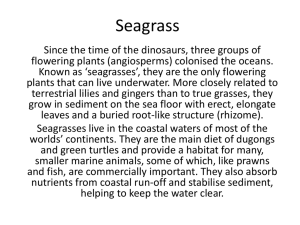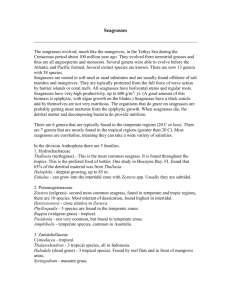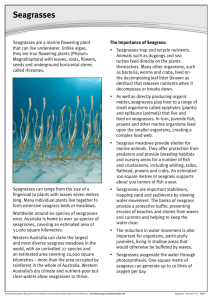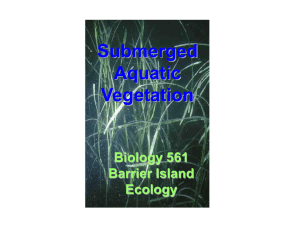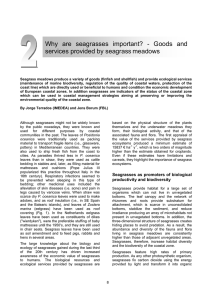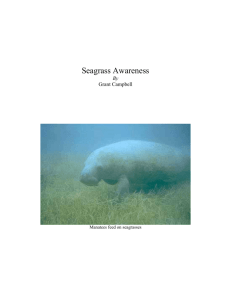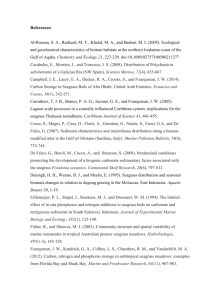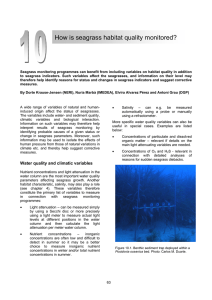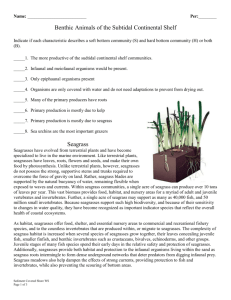Project Report 26 May 2014 Impacts of Seagrasses and Ocean
advertisement
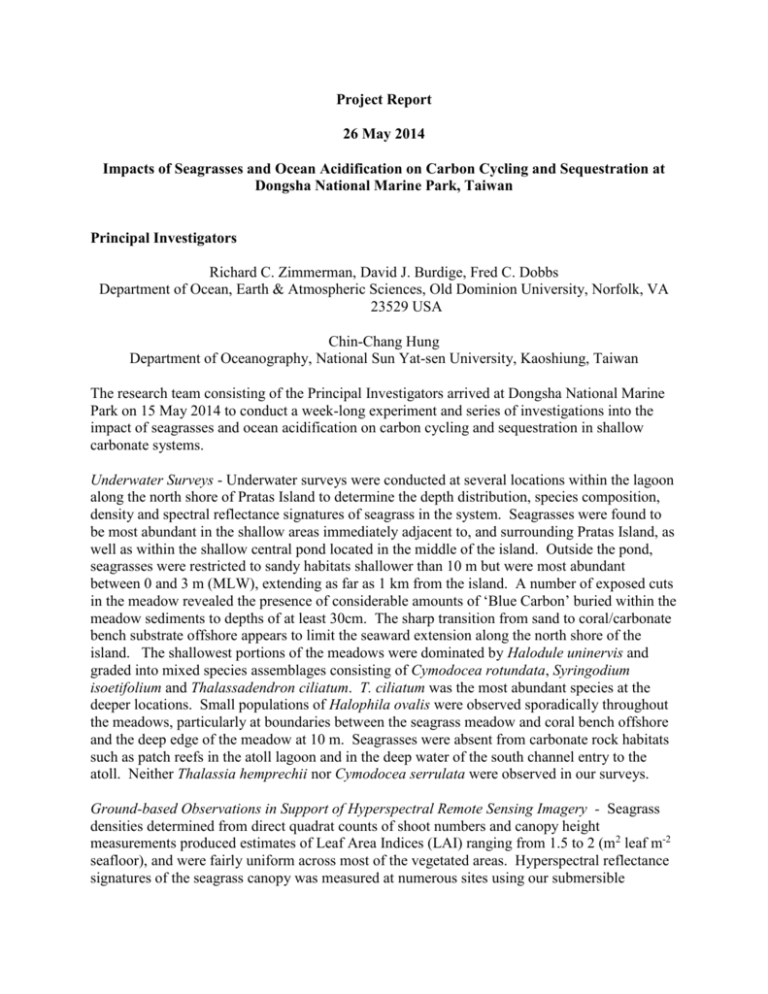
Project Report 26 May 2014 Impacts of Seagrasses and Ocean Acidification on Carbon Cycling and Sequestration at Dongsha National Marine Park, Taiwan Principal Investigators Richard C. Zimmerman, David J. Burdige, Fred C. Dobbs Department of Ocean, Earth & Atmospheric Sciences, Old Dominion University, Norfolk, VA 23529 USA Chin-Chang Hung Department of Oceanography, National Sun Yat-sen University, Kaoshiung, Taiwan The research team consisting of the Principal Investigators arrived at Dongsha National Marine Park on 15 May 2014 to conduct a week-long experiment and series of investigations into the impact of seagrasses and ocean acidification on carbon cycling and sequestration in shallow carbonate systems. Underwater Surveys - Underwater surveys were conducted at several locations within the lagoon along the north shore of Pratas Island to determine the depth distribution, species composition, density and spectral reflectance signatures of seagrass in the system. Seagrasses were found to be most abundant in the shallow areas immediately adjacent to, and surrounding Pratas Island, as well as within the shallow central pond located in the middle of the island. Outside the pond, seagrasses were restricted to sandy habitats shallower than 10 m but were most abundant between 0 and 3 m (MLW), extending as far as 1 km from the island. A number of exposed cuts in the meadow revealed the presence of considerable amounts of ‘Blue Carbon’ buried within the meadow sediments to depths of at least 30cm. The sharp transition from sand to coral/carbonate bench substrate offshore appears to limit the seaward extension along the north shore of the island. The shallowest portions of the meadows were dominated by Halodule uninervis and graded into mixed species assemblages consisting of Cymodocea rotundata, Syringodium isoetifolium and Thalassadendron ciliatum. T. ciliatum was the most abundant species at the deeper locations. Small populations of Halophila ovalis were observed sporadically throughout the meadows, particularly at boundaries between the seagrass meadow and coral bench offshore and the deep edge of the meadow at 10 m. Seagrasses were absent from carbonate rock habitats such as patch reefs in the atoll lagoon and in the deep water of the south channel entry to the atoll. Neither Thalassia hemprechii nor Cymodocea serrulata were observed in our surveys. Ground-based Observations in Support of Hyperspectral Remote Sensing Imagery - Seagrass densities determined from direct quadrat counts of shoot numbers and canopy height measurements produced estimates of Leaf Area Indices (LAI) ranging from 1.5 to 2 (m2 leaf m-2 seafloor), and were fairly uniform across most of the vegetated areas. Hyperspectral reflectance signatures of the seagrass canopy was measured at numerous sites using our submersible radiometer system, revealing a consistent ‘green’ peak around 550 nm that distinguishes seagrasses from reflectance spectra of live corals, bare sand, and coral rubble we also collected. These data will be used to help process the hyperspectral HICO imagery currently scheduled to be collected on 28 May 2014. Ocean Acidification Experiment – We conducted a pilot ocean acidification experiment to determine if CO2-stimulated photosynthesis would increase the dissolution of the carbonate sediment surrounding the roots and rhizomes. Compressed CO2 was delivered to a 1 m circular patch comprised of C. rotundata, S. isoetifolium and T. ciliatum through a 5 m length of weighted diffuser tubing coiled around the patch. Seagrass density within the patch was ~775 shoots m-2, resulting in a Leaf Area Index (LAI) of about 2 m2 leaf m-2 seafloor. The slow trickle of fine gas bubbles raised the CO2 concentration within the patch to about 700 µM (pH 6.5) for 4 days (17 – 20 May 2014). An adjacent patch of similar seagrass density/composition well outside the CO2 enrichment area was selected as a control site. Porewater samples were extracted from both plots shortly after noon each day at 0, 8, 13, and 17 cm depths within the sediment using sipper tubes and hypodermic syringes. On Day 0, porewater alkalinity increased from 2.2 meq l-1 at the sediment surface to about 2.6 meq l-1 at 17 cm depth at both the OA and control patches. By Day 4, the alkalinity at depth within the OA patch had increased to nearly 3.0 while it remained unchanged (~2.6) in the control patch. The difference (~0.4 meq l-1) observed in this simple un-replicated experiment supports the hypothesis that OA may increase delivery of photosynthetically produced O2 through the roots and rhizomes of seagrasses to the sediments, stimulating microbial respiratory production of CO2, leading to carbonate dissolution and shallow water sequestration of atmospheric CO2 by the seagrass meadow. It also suggests the increased alkalinity resulting from this process may act to buffer the negative effects of OA on adjacent corals. Analyses of pore water dissolved inorganic carbon will be carried out at ODU on samples brought back from Dongsha, as a cross-check on our alkalinity determinations. In addition to the above geochemical measurements, we collected samples for microbial ecology analyses. DNA was extracted from samples of sediment and leaf epiphytes in both OA and control plots each day for subsequent sequence analysis and determination of any changes in taxonomic composition of sediment and leaf microbes as a result of OA. A B C Figure 1. A. View of the experimental ocean acidification and control sites (marked by pink flags) from the beach at the west end of the runway on Pratas Island. B. Coil of white diffuser tubing surrounding the experimental OA plot. Small bubbles escaping from the diffuser tubing can be seen as blurry features in the photo. C. Dr. Zimmerman and Dr. Burdige sampling pore water from the OA experimental site using the wellhead sampler buried in the sediment. The CO2 supply tube running to compressed gas tanks on the beach can be seen in the foreground.
